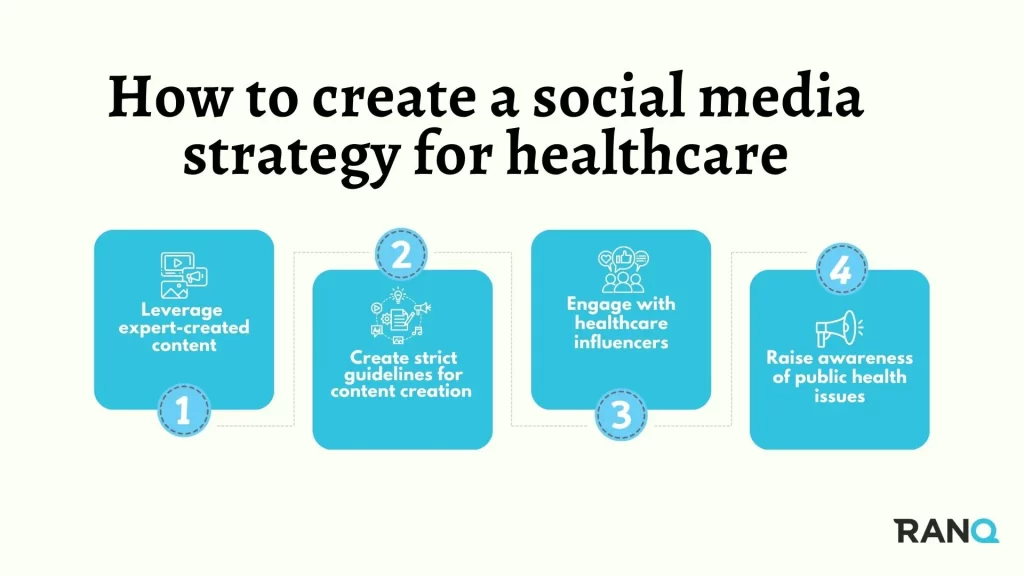Last updated on March 7th, 2025
Social media marketing (SMM) in the healthcare industry can be as impactful as in other service industries. However, navigating social media marketing in the healthcare industry is anything but straightforward.
Social media marketing for healthcare comes with challenges and considerations that require careful analysis and strategy. Since every tweet, post, or video you share carries the weight of your organization’s reputation, your messaging must balance accessibility with accuracy and engagement with ethical compliance.
So, let’s first understand the intricacies of social media marketing, specifically for healthcare organizations, delve into social media strategy, and then explore some social media campaigns that can get you started.
Understanding healthcare social media marketing

Social media marketing for healthcare professionals differs slightly from that of healthcare organizations. Let’s see how both healthcare professionals and organizations/institutions can reap the benefits of social media.
How to use social media in healthcare?
As a healthcare professional, your focus will be on personal branding, establishing trust, and connecting directly with patients. You’ll share insights about medical trends, provide preventative advice, and offer educational content related to your specialty.
Conversely, SMM or social media marketing for healthcare organizations should primarily focus on promoting services, raising awareness about broader health initiatives or policies, and highlighting patient success stories.
Social media marketing for healthcare professionals is aimed at a smaller segment. These are people looking for informative and reliable content on a particular topic or health concern. Meanwhile, SSM for healthcare organizations is often aimed at a larger and more diverse group.
Importance of social media in healthcare
One of the main benefits of social media marketing, compared to traditional marketing, is that it allows you to reach your target audience quickly and cost-effectively. The cost of starting social media for doctors and healthcare organizations is relatively low.
Also, if you structure your messaging right, follow the principles of success on social media, and choose the right type of campaigns, you can effectively connect with a large chunk of your audience quickly. If you master the art of viral content, sometimes this can be overnight.
Social media also plays a crucial role in health education, allowing you to provide patients with timely, reliable information on topics ranging from preventative care to innovative treatment options.
By dispelling myths, reducing stigma around specific conditions, and offering support through informational videos, you can position yourself as a trusted resource for health-related information. This helps build your credibility and, in turn, patient loyalty.
Risks of social media marketing in healthcare industry
For all the benefits, SMM for healthcare also comes with its unique set of risks. There are three primary risks that healthcare professionals and organizations need to be aware of:
- Privacy and compliance: Sharing patient stories or images without consent can breach HIPAA regulations, leading to legal and reputational issues.
- Misinformation and credibility: Posting inaccurate or unverified content can spread misinformation, damaging trust in your organization or practice.
- Ethical challenges: Overly commercialized content can alienate patients. Balancing promotional content with genuine patient care is challenging.
How to create a social media strategy for healthcare

Creating an effective social media strategy for healthcare requires a thoughtful, multi-faceted approach. By using the below guidelines, you can create a safe yet effective strategy for your healthcare organization.
Leverage expert-created content
As a healthcare professional or organization, your audience expects accurate and reliable information from your social media channels. This is why focusing on reliable and expertly created content should be the first and foremost consideration when creating an SMM strategy.
One way of doing this is to collaborate with medical experts to develop content like social media posts, videos, and infographics. Even Google gives higher priority and weightage to content created by experts, emphasizing E-EAT guidelines.
This is relevant as your organization’s blog posts may also be shared on social media. If you share content and information created or backed up by experts, you’ll enhance your credibility and ensure that your messaging is accurate.
Create strict guidelines for content creation
Effective communication is crucial in healthcare, and the stakes are high. Your social media marketing teams may or may not be entirely aware of the risks and challenges associated with the healthcare industry.
Educating your marketing team is a priority, and it’s also essential to create strict guidelines for them to maintain professionalism and ensure compliance with regulations. Clearly define your tone, voice, and acceptable types of content, and train your team to adhere to these standards.
Additionally, protocols for responding to comments on social media platforms and managing sensitive topics should be established to prevent potential missteps. This will not only protect your reputation but also help build a consistent brand voice.
Engage with healthcare influencers
Partnering with healthcare influencers is an effective strategy to broaden your reach and connect with targeted audiences. Here are a few things to take into consideration when choosing influencers to partner with:
Credibility: Ensure the influencer has a strong background in health-related topics. Their audience should trust their knowledge.
Alignment with values: To maintain congruence, the influencer’s values and messaging should align with your organization’s mission and stance on health-related issues.
Audience demographics: Check to see that the influencer’s followers match your target audience in terms of age, interests, and health concerns.
Track record: Review the influencer’s previous collaborations and content history to see that they adhere to ethical practices and have a credible track record.
Raise awareness of public health issues
During the pandemic, social media became an essential tool for healthcare, enabling rapid communication and public health education. Even in the post-pandemic world, social media remains a powerful platform for educating and informing the public about important health topics.
Your strategy should involve clearly defining how your channels will contribute to the ongoing public health campaigns/debates. Use a social media calendar to schedule monthly posts involving different aspects of healthcare education.
This could include tips for preventive care, promoting important initiatives such as vaccination drives, or even creating mental health awareness. You should also schedule different types of social media content, like videos, Q&A sessions, or interactive polls, to spark meaningful discussions and encourage your audience to take action.
Try out these effective social media campaigns for healthcare organizations
Once you have a safe and coherent healthcare social media strategy in place, here are some campaign ideas to get you started:
Share news about preventative health
This is one of the most obvious yet impactful healthcare social media campaigns you can run. Even if your organization is new and wasn’t a part of the social media voices during the pandemic, this is the time to start.
There’s always a continuous stream of health-related research and information on preventative health, so this is also a campaign where you never run out of ideas. You have to use different platforms differently, though, here are some ideas:
- Post an engaging Instagram carousel using graphics and actionable advice. You can also add a poll sticker to your Stories asking relevant health-related questions that your audience can relate to.
- Publish a professional article on LinkedIn or post on your organization’s page titled “The Role of Preventative Health in Workplace Productivity,” targeting corporate professionals and HR leaders interested in employee wellness programs.
- Create a quick, engaging TikTok video demonstrating simple stretches or exercises people can do at home to stay active. Pair it with trending audio and a health-related caption.
Engage with patients looking for answers

Proving answers to the questions patients are seeking is a powerful way to connect while building trust. Many patients turn to platforms like Facebook or Instagram with health questions or concerns, looking for reliable guidance. Addressing these concerns signals to your audience that you’re listening.
One way is to host live Q&A sessions on platforms like Instagram or Facebook on topics such as managing chronic conditions or understanding preventive care. You can also create posts and polls encouraging followers to ask questions and provide thoughtful, empathetic responses.
When getting started, an easy way to determine the specific platforms your patients use is to ask a question in the general information section of your patient intake form. Make sure to make it optional and keep it a multiple-choice question to remove any resistance to filing information.
Squash misleading public health information
Social media is often a breeding ground for misinformation, especially regarding public health. By integrating ‘squashing myths’ content in your monthly social media calendar, you protect your audience and gain credibility. Here are some ideas to leverage different platforms:
- Share an in-depth post on Facebook featuring a side-by-side comparison of a common myth versus the truth, such as “Myth: Antibiotics cure all infections. Fact: Antibiotics only treat bacterial infections.” Don’t forget to Include a link to a trusted medical source for further reading.
- Post a series of myth-busting tweets on Twitter (X) using hashtags like #HealthFacts and #MythBusting. For example: “Myth: Drinking hot water cures COVID-19. Fact: There is no evidence to support this. Stay safe by following public health guidelines. #PublicHealth.
- Post an Instagram carousel debunking common health myths (e.g., “5 Myths About Vaccines – Busted”). Use catchy graphics with credible sources cited in the captions.
Highlight staff accomplishments
Big entities and organizations can often seem cold. Celebrating staff accomplishments on social media humanizes your healthcare organization, helping you connect better with your audience.
Sharing your team’s achievements—whether a doctor receiving an award, a nurse completing advanced training, or a staff member volunteering in the community—does multiple things simultaneously.
It shows the dedication and expertise behind your services while boosting staff morale. At the same time, tagging people broadens the reach of your post, enhancing its impact.
Want to strengthen your healthcare social media marketing? Start working with Ranq
If you really want to boost your social media campaigns, pair it with local SEO and content creation to complement your social media efforts. That’s where we come in! We’re Ranq, and we specialize in healthcare content marketing that performs.
We understand the risks and challenges inherent in digital marketing in the healthcare industry and know how to navigate them. While you conduct your campaigns on social media, don’t let your website and your owned media fall by the wayside. Partner with us for local SEO and healthcare SEO services and create a cohesive online presence that will bolster your social media marketing impact. Contact us for your custom quote.



